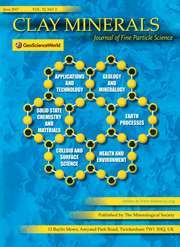Article contents
The relationship between the diabase and clays of the Appeninne clay-schist formation. Experimental work
Published online by Cambridge University Press: 14 March 2018
Extract
Among the lithological types making up the northern Appennines, an important part is played by the (occasionally schistose) clays which make up the main bulk of an enormous nappe (“liguride,” according to Stille) which has slipped from the Ligurian region towards the Po valley. These clays are particularly well developed in the mid-mountain region, and can, because of their plasticity, insinuate into the more recent formations.
Within the argillaceous nappe, frequent nuclei of basic and ultrabasic rocks (gabbros, diabases, serpentines) are observed, of size ranging from that of a pebble to masses of many thousands of cubic meters (Monte Penna, Sasso Tignoso), which appear immersed in the clay mass without having produced in it the well-known contact phenomena.
- Type
- Research Article
- Information
- Copyright
- Copyright © The Mineralogical Society of Great Britain and Ireland 1949
- 3
- Cited by


